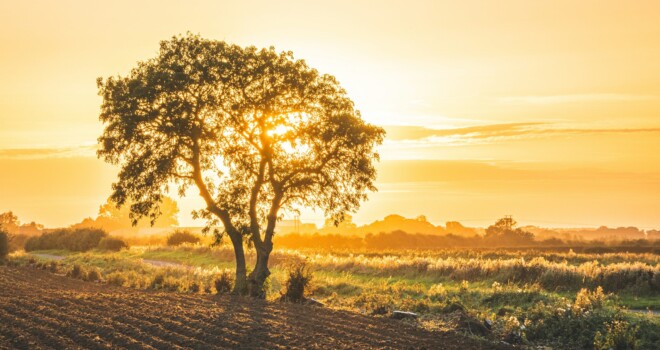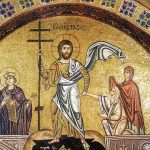I think that I shall never see
A poem lovely as a tree.
A tree whose hungry mouth is prest
Against the earth’s sweet flowing breast;
A tree that looks at God all day,
And lifts her leafy arms to pray;
A tree that may in Summer wear
A nest of robins in her hair;
Upon whose bosom snow has lain;
Who intimately lives with rain.
Poems are made by fools like me,
But only God can make a tree.
The poem above, titled “Trees,” was written by Joyce Kilmer a little over 100 years ago. He was the leading American Catholic poet and lecturer of his day and quite an intellectual. A scholar noted how that didn’t stop critics from disparaging Kilmer’s “Trees” for being “too simple and overly sentimental,” and written in a style that was “too traditional, even archaic.” (That means “. . . because it rhymed.”)
Kilmer’s wife was also an accomplished poet, and they had five children together. So, perhaps his “oversimplistic” poem about trees was written with children in mind. Perhaps he was employing the same strategy as St. Peter when he told the crowd on Pentecost: “They put him to death by hanging him on a tree.” That passage from the Acts of the Apostles gets read on Easter morning. Peter, the first pope or “papa,” the first Holy Father, referred to the cross as a tree perhaps to show that God is a poet; that our life has meaning, our existence has a rhyme and verse to it.
You see, a tree that brought on death is featured in the very beginning of the Bible. And so, in the fullness of time, God sent a new Adam with a new tree to reverse the curse. Theodore the Studite, around the year 800 wrote:
This was the tree on which Christ, like a king on a chariot, destroyed the devil, the Lord of death, and freed the human race from his tyranny. This was the tree upon which the Lord, like a brave warrior wounded in hands, feet and side, healed the wounds of sin that the evil serpent had inflicted on our nature. A tree once caused our death, but now a tree brings life.
This helps explain why the modern critics hated and still hate Joyce Kilmer’s “too traditional” and archaic “Trees.” The poem has too much religion in it. A tree “that looks at God all day” and “raises her leafy arms to pray” is not the kind of tree our modern world appreciates. A professor wrote:
In a world that has flattened out the man-God relationship and degraded ecclesiastical art and architecture to the mundane (the dull and ordinary) the strong vertical line of transcendence in “Trees” is perhaps lost.
(John M. Grondelski)
I mentioned Joyce Kilmer and his wife had five children. At one time they weren’t very religious. That changed when their little daughter Rose was stricken with infantile paralysis shortly after her birth. After a series of correspondence with a Catholic priest, they entered the Church in 1913. In one of his letters to the priest, Kilmer wrote that he believed in the Catholic position for a long time, though he “wanted something not intellectual, some conviction not mental—in fact I wanted Faith.”
After praying for it for months, Kilmer claimed “faith did come, it came, I think, by way of my little paralyzed daughter. Her lifeless hands led me; I think her tiny feet know beautiful paths. You understand this, and it gives me a selfish pleasure to write it down.”
Little Rose Kilmer died at the age of 5 in 1917. The next year Joyce himself, aged 31, died. He was killed by a sniper bullet at the top of a hill in France during World War I. Joyce had been a member of New York’s Irish Brigade, the Fighting 69th. He volunteered for the most dangerous missions, and his fellow soldiers revered him. They were in awe of his cool and calm demeanor in the worst possible situations.
It’s interesting that the Irish-American Kilmer placed robins in his poem. Robins are always heralds of spring. A traditional Irish tale had a robin saving a father and his son from a wolf, when, in the dark of night, the bird swooped down and began beating his wings to fan their dying fire. Despite the pain in its chest, the bird did not stop until the flames began dancing with strength. And from that day, the robin has proudly worn a red breast.
Another story has the robin, feeling Christ’s agony on Good Friday, swooping down to pull a thorn out of his brow. Either some of Christ’s blood fell on the bird’s breast, or the bird was wounded. Either way, the robin was blessed for the act of heroism. (Cathy S. Mosley)
Those stories got started no doubt because some child asked, “How did the robin get its redbreast?” And the child received a Christianized answer, one that encouraged the child to look around at creation and see God all day.
One day I noticed two baby robins fresh out of the nest, standing below our crucifix outside of church. The birds were positioned on each side of the crucifix, under its shade, waiting for their mother to swoop down and feed them. It reminded me of the image given in Psalm 42, where two deer on each side of the cross drink from the life-giving stream that flows from it.
We can find God in creation, and we can see something Christ-like in the man of faith, Joyce Kilmer, a man who found faith in looking at trees and little hands. It’s interesting: Christ volunteered for the most dangerous of missions in ransoming mankind. People were in awe of His cool and calm demeanor in the worst possible situation on Good Friday. And Christ was killed at the top of a hill, aged 33. For this we revere and adore Christ. We worship Him.
We don’t worship trees like the pagans. We don’t argue that trees should be granted personhood status, like some fools are doing today. We understand that trees, like all creation, are contingent on their Creator.
And so, my friends, understand: Only God can make a tree. And only God can raise you from the dead. That gives meaning to your short life on earth. It gives rhyme and reason to your existence. You die with Christ, you rise with Christ. Isn’t that poetic?
Only God can make a tree. And only God can turn bread and wine into His Body and Blood. At Holy Mass we kneel under the shade of the Tree of Life and wait for Christ to swoop down and feed us. And in eating His Body and Blood we are drawn up from earth to heaven.
Do you want faith? Then pray for it. Pray for the truth in a world that laughs it off as too traditional and archaic. Know that your life is a poem made by God. How will your poem end?
Pray to believe in the Holy Eucharist, the True Food that puts life in you. The Eucharist gives you the strength to carry your cross, to keep a cool and calm demeanor in the worst possible situations. The Eucharist will give you the eyes to look at God all day. And when He raises you from the dead, you will look upon Him forever.
Photo by Luke Thornton on Unsplash
















